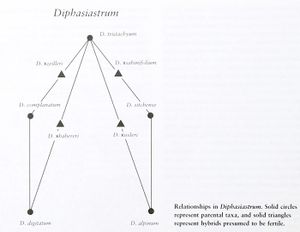Difference between revisions of "Diphasiastrum"
Preslia 47: 104. 1975.
FNA>Volume Importer |
imported>Volume Importer |
||
| (One intermediate revision by the same user not shown) | |||
| Line 90: | Line 90: | ||
|publication year=1975 | |publication year=1975 | ||
|special status= | |special status= | ||
| − | |source xml=https:// | + | |source xml=https://bitbucket.org/aafc-mbb/fna-data-curation/src/2e0870ddd59836b60bcf96646a41e87ea5a5943a/coarse_grained_fna_xml/V2/V2_502.xml |
|genus=Diphasiastrum | |genus=Diphasiastrum | ||
}}<!-- | }}<!-- | ||
-->[[Category:Treatment]][[Category:Lycopodiaceae]] | -->[[Category:Treatment]][[Category:Lycopodiaceae]] | ||
Latest revision as of 20:23, 5 November 2020
Plants terrestrial, mainly trailing on ground with erect shoots. Roots emerging immediately on underside of main stems. Horizontal stems on substrate surface to subterranean, long-creeping. Upright shoots quadrate to flattened (except in D. sitchense), 2–6 mm diam., usually with 2–5 lateral branchlets on main erect stem; lateral branchlets leafy, ± flat in cross section. Leaves on horizontal stems somewhat distant, appressed, linear to lanceolate, thin, scalelike; leaves on ultimate branchlets appressed to divergent, linear-lanceolate to nearly filiform, usually almost scalelike and mostly imbricate, in 4 ranks, leaves of lateral ranks larger, more spreading than those of upperside and underside ranks (except in Diphasiastrum sitchense with 5 ranks of uniform nonimbricate leaves). Gemmiferous branchlets and gemmae absent. Strobili solitary and sessile or multiple and stalked, apex blunt, acute, or with sterile apical projection; peduncle conspicuously leafy; sporophylls shorter than peduncle leaves. Sporangia reniform. Spores reticulate, sides at equator convex, angles acute. Gametophytes nonphotosynthetic, mycorrhizal, carrot-shaped, paraphyses absent; ring meristem present. x = 23.
Distribution
Mainly north temperate and subarctic.
Discussion
Diphasiastrum is remarkable in North America for its ability to form numerous homoploid, apparently fertile interspecific hybrids, some of which are frequent to common and must be reckoned with in floristic studies. Field and laboratory studies of these hybrids and their parents are needed for determination of the population dynamics of Diphasiastrum and to answer questions as to why the parental species retain their genetic identities.
Species 15–20 (11 taxa in the flora, including 5 species and 6 fertile hybrids).
Selected References
Lower Taxa
Key
| 1 | Upright shoots to 18 cm, mostly less than 12 cm including base; strobili mostly sessile. | > 2 |
| 1 | Upright shoots, 8–50 cm, mostly more than 12 cm, including base; strobili stalked. | > 3 |
| 2 | Ultimate branchlets approximately square in cross section; leaves 4-ranked, strongly overlapping. | Diphasiastrum alpinum |
| 2 | Ultimate branchlets round in cross section; leaves 5-ranked, not overlapping. | Diphasiastrum sitchense |
| 3 | Ultimate branchlets cordlike, nearly square in cross section, usually bluish glaucous; underside leaves approximately equal in size to lateral and upperside leaves. | Diphasiastrum tristachyum |
| 3 | Ultimate branchlets narrowly bladelike, flat in cross section, usually green; underside leaves much smaller than lateral and upperside leaves. | > 4 |
| 4 | Branchlets irregular, with conspicuous annual bud constrictions; peduncles, if present, regularly forked; strobili mostly 15–25 mm, lacking sterile tips. | Diphasiastrum complanatum |
| 4 | Branchlets very regularly fan-shaped, lacking conspicuous annual bud constrictions; peduncles mostly branching abruptly at base to produce false whorl of strobili; strobili mostly 20–35 mm, many with sterile tips. | Diphasiastrum digitatum |
